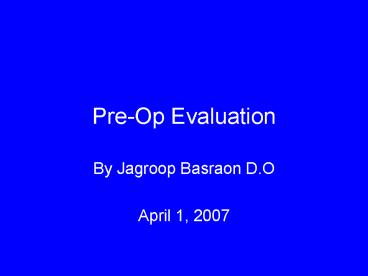PreOp Evaluation - PowerPoint PPT Presentation
1 / 14
Title:
PreOp Evaluation
Description:
... Heart Failure, Unstable Angina, Significant Arrhythmias, and valvular heart disease ... Pulmonary disease patients may require ... Valvular Heart Disease ... – PowerPoint PPT presentation
Number of Views:126
Avg rating:3.0/5.0
Title: PreOp Evaluation
1
Pre-Op Evaluation
- By Jagroop Basraon D.O
- April 1, 2007
2
Pre-Op Objective
- Assess current medical status
- Address cardiac risks posed by planned operation
- Recommend strategies to decrease risk
- Usually consists of basic observation by
internists - Good history and physical exam is necessary
3
Clinical Evaluation
- Identify any current cardiac conditions which
place the patient at high risk - Recent MI, decompensate Heart Failure, Unstable
Angina, Significant Arrhythmias, and valvular
heart disease - Address other current co-morbid conditions such
as Diabetes mellitus, Vascular disease, Hx of
stroke, renal disease, and pulmonary disease - Address functional capacity based on patients
ability to perform daily tasks. (METS 1-4 normal,
4-10 active, and gt10 strenuous exercise)
4
Physical Exam
- BP in both arms
- Carotid pulse and bruits
- Heart sounds and extremity pulses
- Lung field auscultation
- Abdomen exam, focus on any Aneurysm
- Concerning findings, Aortic stenosis murmur, JVD,
S3, pulmonary edema
5
Type of Surgery
- High Risk Procedures (gt5 risk) Emergent
procedures in elderly, Aortic or peripheral
vascular surgery, Extensive operation w/volume
shifts - Intermediate Risk (lt5 Risk) orthopedic,
urological, intraperitoneal and intrathoraic,
head and neck surgery, carotid endarterectomy - Low Risk(lt1 Risk) Breast surgery, Cataract,
Endoscopic procedure, superficial procedure
6
Lab Evaluation
- Routine Test CBC, Chem 10, LFTS to evaluate
liver and renal function if needed - Coagulation tests for patients with coagulopathy,
familial or acquired - Pulmonary disease patients may require
pre-operative ABG - ECG (usually Mandatory) look for blocks,
pauses, arrhythmias, prior MI
7
Criteria
- Compile History, Physical exam, lab values to
provide overall index/risk for the patient - Main ones include Goldmans, Eagle, ACC/AHA. Easy
referenced on the web. - http//www.acc.org/qualityandscience/clinical/guid
elines/perio/update/periupdate_index.htm - High risk patients need further testing, usually
in form of cardiovascular stress test before
proceeding unless in emergent situation. These
include patients with unstable coronary
syndromes, dysrythmias, decompensated CHF
8
Special Cases
- Valvular Heart Disease
- Critical Aortic stenosis must be recognized and
corrected before any non-cardiac surgery - Mitral Stenosis mild and asymptomatic managed
medically. Severe or symptomatic needs to be
addressed first. - Aortic/Mitral Regurg- optimize with diuretics and
afterload before surgery - Appropriate prophlaxsis for endocarditis for
prosthetic valves - Prosthetic Valves switch to IV
anti-coagulation,d/c oral (i.e coumadin)
9
Special Cases - cont
- Arrhythmias and conduction disease
- Supraventricular Tachycardias- need to be rate
controlled and underlying cause managed
w/hemodynamically significant cause requiring
cardioversion - Ventricular Arrhythmias may require
preoperative supperessive therapy (i.e
Lidocane/Amiodaraone depending on local
preference) - Bradyarrthmia are managed with temporary pacing
as needed. - Permanent Pacemaker are checked pre and
post-operatively
10
Special Cases - cont
- Hypertension severe, diastolic gt110 needs to be
controlled. Rapid active b-blockers are
preferred, because of anti-ischemic properties - Cardiomyopathy LV dysfunction may require swan
guide hemodynamic optimization. Hypertrophic
Cardiomyopathy usually required close volume
control.
11
Special Cases- cont
- Coronary Artery Disease pre-operative CABG and
prophylactic PCI have had different outcomes in
different populations, no consensus. - B-Blockers have been show to reduce mortality.
- Give B-blocker to any patient who has risk
factors for CAD, known CAD, peripheral vascular
disease, and symptomatic arrhythmias. - NTG if need for symptomatic ischemia in patient
who have daily use. - CONSULT CARDIOLOGY IF IN DOUBT
- Ca channel blockers do not have sufficient data
12
Special Cases
- Carotid Disease Tx remains controversial
- Individualized strategy.
- Carotid Endarteretomy with or without CABG have
had similar outcomes. - CONSULT CARDIOLOGY
13
Conclusion
- Good history and physical exam required
- ECG required
- Look for symptomatic cardiovascular disease (MI,
CHF, carotid disease) - Peri-operative B-blocker therapy in CAD and
equivalents - Address any other active acute medical issues.
- CONSULT and delay surgery if in doubt.
14
Reference
- References
- Goldman L, Caldera, Multifactorial index of
cardiac risk in noncardiac surgical procedures. N
Eng J of Medicine 1977. - Landmark Articles
- Eagle KA, Rihal CS, Mickel MC. Cardiac risk of
noncardiac surgery 199796188201887 Circulation - AHA/ACC Periopertive Guideline. On AHA website






























